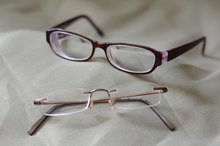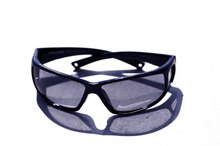Problems With Transition Lenses
Transition lenses offer the convenient advantage of eye protection from the harsh rays of the sun on demand. Known as "photochromatic" lenses, these eyeglasses darken under bright sunlight to serve as sunglasses, then return to a clear lens when the wearer moves indoors or out of direct sunlight 1. As helpful as these glasses may seem, a few problems exist that make their use a tossup.
Cost
Photochromatic lenses are typically embedded with photo-sensitive chemicals or coated with similar films that produce the shading effect when exposed to light 1. This process makes the lens more expensive to manufacture and focus into prescription glasses, thereby raising the cost of the glasses for the consumer. Though individual insurance companies may price lenses similarly, the price of transition lenses can be twice the price of regular glass lenses.
Driving
How to Tell If My Oakleys Are Polarized
Learn More
Car windshields typically come standard with antiglare effects or films and laminates that break up some of the direct sunlight that enters the vehicle. This essentially nullifies transition lens effects, causing them to register a non-lit condition when the direct sunlight can actually be very bright. Relying on photochromatic lenses while driving may not only be inconvenient, it may be unsafe if the driver depends on the prescription to see or is legally bound to wear prescription lenses while driving 1.
They're Not Sunglasses
Transition lenses are typically the size and shape of regular vision-correction lenses. This allows them to accurately correct the field of vision, but does not account for peripheral areas on either side of the visible range. Sunglasses operate by maintaining very dark glass that expands over the field of vision and the periphery with large, oblong lenses that block sunlight from both the front and sides. Transition lenses are not typically dark enough for heavy sun and do not block light penetration on the periphery, often resulting in the wearer having to resort to sunglasses anyway.
- Transition lenses are typically the size and shape of regular vision-correction lenses.
- Transition lenses are not typically dark enough for heavy sun and do not block light penetration on the periphery, often resulting in the wearer having to resort to sunglasses anyway.
Tint Loss
Problems With High Density Eyeglass Lenses
Learn More
After the initial manufacturing of a photochromatic lens, the chemicals or film applied to the lenses move in and out of tint rapidly and reliably 1. However, this reliability starts to degrade over time, resulting in lenses that stay slightly tinted all the time, do not tint as darkly or as quickly as before, and can actually stay fully-tinted for long periods of time after leaving direct sunlight. Wearing old transition lenses that exhibit a permanent tint can actually cause you to adjust to that tint and affect your normal vision and adjustment to light, nullifying the convenience of having photochromatic lenses 1.
Related Articles
References
- All About Vision: Photochromatic Lenses
- Alvarez TL, Kim EH, Granger-donetti B. Adaptation to Progressive Additive Lenses: Potential Factors to Consider. Sci Rep. 2017;7(1):2529. doi:10.1038/s41598-017-02851-5
- Han SC, Graham AD, Lin MC. Clinical assessment of a customized free-form progressive add lens spectacle. Optom Vis Sci. 2011;88(2):234-43. doi:10.1097/OPX.0b013e31820846ac
Writer Bio
Chet Carrie has been writing since 2004. He served as an editor for a university magazine and has freelanced for several newspapers. Carrie holds a Bachelor of Arts in English.









